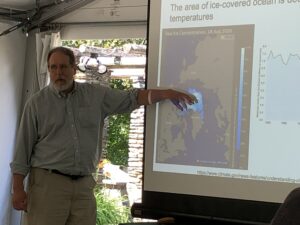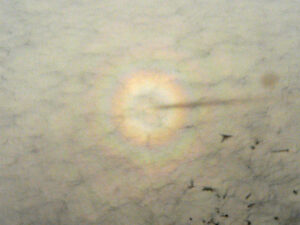Fred Huemmrich is a member of NASA’s Plankton, Aerosol, Cloud, ocean Ecosystem (PACE) science and applications team and a research professor at the University of Maryland, Baltimore County.
What is your favorite atmosphere, land, or ocean related book or movie?
“Dune.” To be specific, I really liked the appendix of Dune which has the story of the imperial planetologists, and when I read that as a kid it was the first time I ever thought of the concept of looking at an entire planet’s ecosystem. So, my goal in life is always to become an imperial planetologist.

How will PACE help your research?
One of the things that I’m really interested in is the dynamic of ecosystems on land, and how they change over time. PACE really excites me because it’s an opportunity to look – with new, hyperspectral data – at seasonal dynamics of these ecosystems, or even shorter-term effects like droughts or heat stress or cold snaps. With the hyperspectral data available from PACE and OCI we’ll be able to do things like look at changes in leaf level pigment contents and biochemistry. Plants are constantly altering themselves to adjust to the environment and that is something we can see from data on the light that reflects off them. I’m really excited about PACE giving us this data of time series for vegetation types all over the world.
What are you most looking forward to after launch?
I envision doing a study, looking at the indices of plant conditions globally, after the first month of data. I’m going to make a global map because we just don’t even know what it will look like. That’s going to be the first step after launch.
OCI on PACE is going to be able to look at all the colors of the rainbow. What is your favorite color and why?
My favorite color is one you can’t see! Almost all the light that hits plant leaves in the visible wavelengths gets absorbed, except there’s a little hump in the green that they don’t quite absorb as much, which is why we see them as green. But just beyond what we can see, in the near-infrared, leaves have almost no absorption. If we could see leaves in the near-infrared it would almost be like looking at like highway signs that like reflect light back on you really brightly. In green leaves the transition from the visible wavelengths to the near infrared wavelengths is called the red edge and measuring it gives you a lot of information about how much chlorophyll is in leaves.
Do you have a favorite plant?

One that I’m fond of is black spruce. Over the years I’ve done a fair amount of work in the boreal forests. In fact, just last this past summer I was doing fieldwork in the boreal forests in Alaska. I’m really interested in seeing if we can use the PACE data to detect changes in the spruce needle biochemistry that we can’t do with the satellites we have now.
What is a fun fact about yourself?
I worked my way through college in a brewery!
What is some advice that you would give to aspiring scientists who are looking to be where you are today?

One of the pieces of advice I give to my undergraduate students is that when I was an undergraduate, not only did I not know what I was going to end up doing, I didn’t know that what I ended up doing even existed. Very often undergraduates don’t have a lot of experience in the range of jobs available in the world. And that’s, of course, changing all the time with technology. One of the things that’s important for them to do is to look around and try to get outside of a narrow thing that they’re focused on, and spread out a little bit to look at what might be available because they might be surprised at what they find.
What is one catch-all statement describing the importance of PACE?
PACE is going to give us a fundamentally new view of the way ecosystems work on the planet.
Header image caption: Fred measuring spectral reflectance and photosynthesis in a cornfield. These types of measurements are used to develop approaches for applying PACE data to determine crop productivity. Courtesy: Fred Huemmrich
By Erica McNamee, Science Writer at NASA’s Goddard Space Flight Center







